Library Reference Number: 251
Military Aircraft At Sea - Part 4
In this fourth and final part of the series, and in addition to Library Entries 174, 235 and 248; this section is devoted towards an ever uncertain future and where the soaring costs of defence hardware procurement is prompting even the richest nations to revise what they can comfortably afford. The Joint Strike Fighter (JSF) initiative begun in the 1990s is an illustrative example of several governments working and investing together to produce affordable military aircraft for the future.
Predictably, the largest single investor became that of the USA whose continued commitment to forward defence strategies was more fully described in Library Entry 248 and requires no repetition here. Surprisingly though, the United Kingdom features in a singular category of secondary investor and where the decision to ground and destroy all Harrier GR series aircraft makes sense following the UK defence review of 2010 and where the Lockheed-Martin F35b Lightning II will replace the Harrier. There are several other countries rated at the Level Three investment category that also intend to buy the new aircraft of which there are three variants.
The F-35a is designed as all weather stealth tactical fighter aircraft developed for use by Air Forces. The F-35b is the STOVL version and which is attracting most interest at present and especially in the UK since the British government has cancelled the installation of CATOBAR equipment on the new ‘Queen Elizabeth’ class aircraft carriers currently in building (2014) on the basis of economic stringency. Sadly, this means that one of the major design objectives to achieve homogeny with other aircraft carriers owned by NATO member states and especially those of the United States has been sacrificed. This author predicts that some form of catapult launch system will be retrofitted in the future and perhaps EMAL as currently being tested on the USS Gerald R Ford. In the meantime, however, it means that the new aircraft carriers are incapable of using the F-35c maritime aircraft carrier variant and which requires some form of catapult launch and recovery system. The British order for F-35c aircraft has thus been altered to the F-35b model whose range and weapons payload is less than the former.
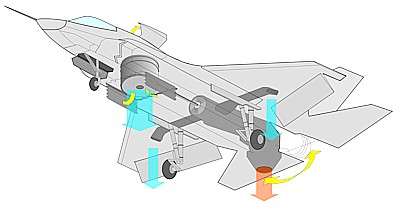 At first glance, it looks very similar to the highly successful Lockheed Martin F-22 ‘Raptor’ but comparison ends swiftly with the details. When the Joint Striker Force (JSF) project was begun in the 1990s, potential designs and rivals to win the highly lucrative contract were invited to compete. The McDonnell-Douglas entry was ruled out on account of high complexity even before it was given a chance to fly. The Boeing entry met much of the criteria but then failed when the aircraft was placed in hover mode and where exhaust fumes, blown back into the jet air intakes, prompted the engines to overheat. The Lockheed-Martin competitor closely matched the desired specification and in which it could take off vertically and then fly at a supersonic speeds. The F-35b Lightning II is also blessed with ‘radar contouring’ and energy absorbing paints to make it virtually invisible to the majority of regular radar systems.
At first glance, it looks very similar to the highly successful Lockheed Martin F-22 ‘Raptor’ but comparison ends swiftly with the details. When the Joint Striker Force (JSF) project was begun in the 1990s, potential designs and rivals to win the highly lucrative contract were invited to compete. The McDonnell-Douglas entry was ruled out on account of high complexity even before it was given a chance to fly. The Boeing entry met much of the criteria but then failed when the aircraft was placed in hover mode and where exhaust fumes, blown back into the jet air intakes, prompted the engines to overheat. The Lockheed-Martin competitor closely matched the desired specification and in which it could take off vertically and then fly at a supersonic speeds. The F-35b Lightning II is also blessed with ‘radar contouring’ and energy absorbing paints to make it virtually invisible to the majority of regular radar systems.
Trouble is, the Lockheed-Martin F35b Lightning II is expensive to buy and the soaring price has already meant reductive revisions for aircraft by several governments.
Italy initially ordered twenty-two of these aircraft with intent to equip their latest assault ship, ‘Cavour’ with such aircraft but the order has since been downgraded to sixteen. In Canada, a major political storm broke out concerning the cost of acquiring these aircraft. The British order was changed for the reasons outlined above.
The diagram illustrates the principles employed on the Lockheed Martin F-35b model. In the course of normal flight, the main jet engine provides propulsion in line with the fuselage but upon entry into its vertical landing mode, the exhaust of the main engine is rotated into a vertical thrust position. At the same time, a large canopy lifts up from a position just behind the pilot and provides the air intake for what is effectively another jet engine to provide vertical thrust for the forward weight of the aircraft. Two side exhausts, one in each wing, help to keep the aircraft stable as it descends.
In terms of marketplace, the F-35b Lightning II is the obvious successor to the Harrier but it also greatly enhances the capabilities of the new generation ‘Landing Helicopter Deck’ ships described later of which several are in building around the World. Smaller escort carriers and which are normally restricted to use of helicopters are likely candidates for such aircraft.
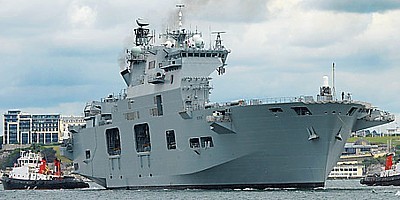 The hastily conducted UK defence review by the newly elected Conservative-Liberal coalition government was predicted to be savage and so it proved. Leuchars air base in Fife was to be closed leaving Lossiemouth as the only major air base in Scotland with a coverage reaching from the North of England to the Artic Circle. Less predicable aspects of the defence review involved scrapping the entire fleet of the Nimrod early warning aircraft and the rapid decommission and scrapping of HMS Ark Royal. Within weeks, the latter followed the path of its sister ship, HMS Invincible, to a Turkish scrapping yard. The last of the ‘Invincible class’ ships was HMS Illustrious and this was re-assigned as a helicopter assault ship while HMS Ocean, a ship better designed for this task was in refit. Once the latter was returned to service in June 2014, HMS Illustrious was immediately retired from service and decommissioned in August 2014 leaving the Royal Navy without a frontline carrier for the first time in decades.
The hastily conducted UK defence review by the newly elected Conservative-Liberal coalition government was predicted to be savage and so it proved. Leuchars air base in Fife was to be closed leaving Lossiemouth as the only major air base in Scotland with a coverage reaching from the North of England to the Artic Circle. Less predicable aspects of the defence review involved scrapping the entire fleet of the Nimrod early warning aircraft and the rapid decommission and scrapping of HMS Ark Royal. Within weeks, the latter followed the path of its sister ship, HMS Invincible, to a Turkish scrapping yard. The last of the ‘Invincible class’ ships was HMS Illustrious and this was re-assigned as a helicopter assault ship while HMS Ocean, a ship better designed for this task was in refit. Once the latter was returned to service in June 2014, HMS Illustrious was immediately retired from service and decommissioned in August 2014 leaving the Royal Navy without a frontline carrier for the first time in decades.
The picture shows HMS Ocean leaving port after its refit and representing new confidence in the massively improved capabilities of all weather helicopters.
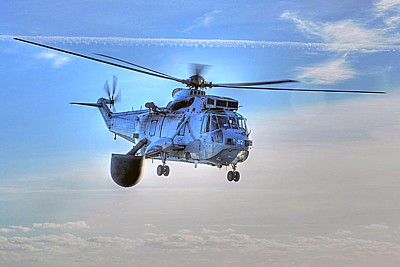 When the British government chose to abandon the fitment of CATOBAR on the ‘Queen Elizabeth’ class of ships, it also excluded the use of Hawkeye early warning aircraft as commonly applied elsewhere. Instead, the plan is to use a new system under development called ‘Crows Nest’ and using an all weather helicopter for this vital task.
When the British government chose to abandon the fitment of CATOBAR on the ‘Queen Elizabeth’ class of ships, it also excluded the use of Hawkeye early warning aircraft as commonly applied elsewhere. Instead, the plan is to use a new system under development called ‘Crows Nest’ and using an all weather helicopter for this vital task.
It’s a far cry from the days of 1982 when the Falklands Crisis began and where the British Navy Task Force initially lacked any form of air bourn early warning systems. In haste, the Royal navy received modified Wessex helicopters that could provide this function and the RN AEW.2 and AEW.5 led on to the Sea King AsaC7 as operated by the ‘Invincible class’ of aircraft carriers in later years.
Of course, the use of helicopters for this role isn’t unique or confined to British employment. HMS Ocean is regarded as a LPH (landing pad helicopters) but this distinction is becoming increasingly rare, as the new generation of LHD assault ships are likely to replace them in future. HMS Ocean is the only ship of this type classification in the Royal Navy.
HMS Ocean has a roughly approximate cousin in the Spanish ‘Juan Carlos I’ and which is also similarly classified as an LPH and where the early air bourn warning function is conducted by a variant of the venerable Sikorsky SH-3 ‘Sea King’ helicopter first introduced as an anti-submarine helicopter in 1961 and using turboshaft engine technology for the first time. The USA also used this model for decades before replacing it with the Sikorsky SH-60 ‘Seahawk’ helicopters. The classification of LPH in the US Navy was mainly applied to ‘Iwo Jima’ class small carriers and three Essex class carriers in the past but none of these remain in current service.
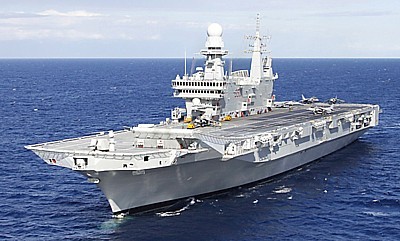 They’ve been replaced by a new generation of ships more suited to the role of attack and assault with cargo decks and launch facilities for the deployment of troops, tanks and other military vehicles while aerial support is conducted by helicopters. For the purposes of brevity, this author will be using the classification of ‘LHD’ during the remainder of this text to mean both variants since the application and use of both is similar.
They’ve been replaced by a new generation of ships more suited to the role of attack and assault with cargo decks and launch facilities for the deployment of troops, tanks and other military vehicles while aerial support is conducted by helicopters. For the purposes of brevity, this author will be using the classification of ‘LHD’ during the remainder of this text to mean both variants since the application and use of both is similar.
Agusta Westland EH-101A AEW helicopters of the Italian Navy are operated from the aircraft carriers Cavour and Garibaldi. Russian built Kamov Ka-31 helicopters fitted with the E-801 Oko (Eye) system fitted with the airborne electronic warfare radar system can track twenty targets simultaneously and detect potentially hostile aircraft up to ninety miles away (150km) and surface warships up to 160 miles away (250km). The Indian Navy uses these Russian built helicopters on the INS Vikramaditya aircraft carrier and on Talwar class frigates. Plans for the new ‘Vikrant’ class currently in building (2014) will also include these helicopters in the AEW role. Not too surprisingly, Russia’s solitary aircraft carrier, the ‘Admiral Kuznetsov’ also employs this same form of aerial early warning.
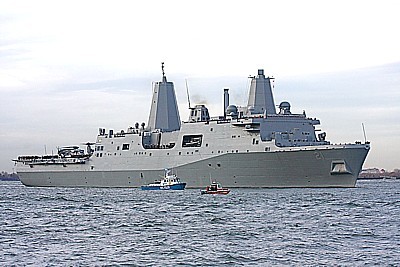 In terms of military aircraft at sea, the new generation of Landing Helicopter Docks (LHD) is one where the role of a frontline aircraft carrier becomes mixed with that of an assault ship with a high freeboard to accommodate additional decks for the loading of tanks and armoured vehicles and where the latter is fitted with equipment permitting their launch from a ramp and ability to ‘swim’ towards the coastline whilst troops are landed by helicopters and supported by aerial helicopter gunships!
In terms of military aircraft at sea, the new generation of Landing Helicopter Docks (LHD) is one where the role of a frontline aircraft carrier becomes mixed with that of an assault ship with a high freeboard to accommodate additional decks for the loading of tanks and armoured vehicles and where the latter is fitted with equipment permitting their launch from a ramp and ability to ‘swim’ towards the coastline whilst troops are landed by helicopters and supported by aerial helicopter gunships!
Arguably and writing in 2014, the most sophisticated exemplar of this kind of ship might be the ‘USS New York’ pictured and where the rear dock area has the capability to be flooded and launch troop landing craft, tanks fitted with flotation skirts and cargo supply craft. Helicopters can land troops whilst maintaining the roles of ASW and AEW. Sadly, it also contains a major casualty hospital far larger than commonly seen on other warships and reflecting its probable role in wartime.
The proposed design for the HMAS Canberra presented in the picture below illustrates the mixed concept of LHD ships; neither front line aircraft carrier nor assault ship. For the majority of nations currently using aircraft carriers, this is the long-term future.
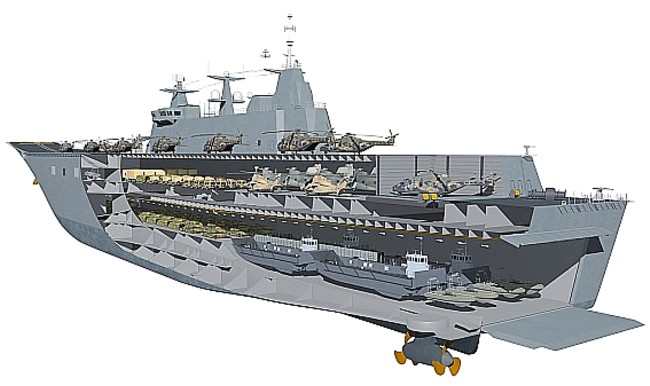
In closing this series, Military Aviation at Sea will undoubtedly continue to be a major part of forward defence, escort and support strategies and where the sad realisation that is that naval and air forces working on their own are unlikely to win wars yet prevent defeat. Ultimately, it is events occurring in the war zone on land that typically determines the outcome.

